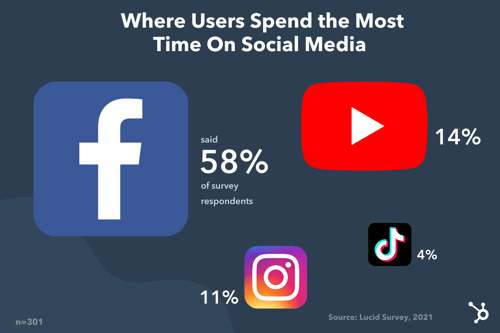Every day there’s something new on social media.

Recently, Twitter introduced Twitter Blue, a premium subscription-based version of its platform.
TikTok took the social media world by storm back in 2020 and still remains the most downloaded app of 2021, according to Social Media Today. Instagram is regularly adding new features to its platform, recently testing a new affiliate tool for influencers.
The question is, how are these changes impacting how consumers behave online? Are users moving away from Facebook?
Let’s see what the data says and what it means for brands.
Where do consumers spend the most social time?
Consumers spend the most time on Facebook, followed by YouTube. These two platforms dominate the social media world, each with over 2 billion monthly active users.
We surveyed 301 people in the United States and asked, "Which social media platform do you spend the most time on each week?" The response was kind of surprising.

Despite YouTube’s steady growth over the past year and the rise of TikTok and Clubhouse, Facebook remains the top social media platform. YouTube follows, with the gap between the platform and Facebook much smaller in larger surveys.
So, what does this information really mean?
Well, in a broad sense, it means you should consider having a presence on these platforms. However, don’t delete your Instagram account just yet – better yet, don’t delete it at all.
I’ll explain why later.
Check out The State of Social Media in 2023: How You Can Build Communities, Drive Sales, and Go Viral, According to 1,000+ Social Media Managers
Which Social Media Platforms Marketers Are Prioritizing
In 2022, Facebook is the number one social media platform marketers are focusing on, according to HubSpot Blog Research.
When asked which social media platform they plan to invest the most in for 2022, 25% answered Facebook, 20% said YouTube, 16% said Twitter, and 15% said Instagram.
Facebook seems to generate the highest quality leads for marketers, according to the data, which explains why marketers are leveraging this platform the most.
TikTok is another popular platform that 52% of marketers surveyed plan to increase their investment in. There are two reasons for this: The first is that short-form video is growing and increasingly becoming the number one content format. In fact, it’s the format 26% of marketers are leveraging the most in 2022.
In addition, 46% of marketers surveyed said that TikTok offered the highest ROI among other platforms like Twitter and YouTube.
When it comes to emerging platforms and/or features, marketers are keeping an eye on YouTube Shorts. According to 2021 HubSpot Blog Research, 83% of marketers plan to increase their investment in the short-form video feature, a TikTok competitor.
Facebook Live Audio and Twitter Spaces are also top features marketers plan to increase their investment in for 2022.
This focus on audio and short-form video platforms reflects 2021 HubSpot Blog Research that revealed that marketers are investing most in short-form videos and live audio chat rooms in 2022.
According to the data, most marketers (over 60%) say short-form videos are the most effective format and offer the highest ROI, followed by live videos and live streaming. As for audio, 44% of marketers plan to leverage it for the first time in 2022.
The key takeaway is that audio and short-form video platforms will play a much bigger role in marketers’ strategies in 2022 than they have in the past.
Which Social Media Platforms Are Losing Steam
When Clubhouse first launched in 2020, it gained steam very quickly with its unique live audio concept. Its invitation-only model also helped build excitement around the platform.
Today, the platform is open to the public and seems to have lost its edge, as other (and bigger) social platforms launch their own version of live audio.
HubSpot Blog Research conducted in 2021 found that 15% of marketers plan to decrease their investment in the app for 2022.
Snapchat is another platform that marketers are divesting from. Our research found that when it comes to influencer marketing this year, 20% of marketers are planning to decrease their investment in Snapchat.
It also revealed that Snapchat offers one of the lowest ROIs, behind Pinterest and Twitch.
So, does this mean you should stop marketing on Clubhouse and Snapchat? Not if your audience lives there and your brand sees an average to high return from it.
Take this data as a guide to keep you informed on industry trends and insights, not a strict playbook. So, if your data suggests that these platforms are worth investing in, continue to do so.
Should brands limit their efforts to the most popular platforms?
There’s no single, clear-cut answer to this... but typically, no.
While most consumers may spend most of their time on Facebook and YouTube, that doesn’t mean you should dedicate all your efforts entirely to those platforms.
Why? That may not be where your audience lives.
Generality is the enemy of marketing. Imagine running a social media ad that targets everyone. Or having a target audience comprising all of Gen Z.
This sort of one-size-fits-all isn’t conducive to your brand’s growth. In fact, it is likely keeping you from making progress, as you waste time and resources on broad strategies that may not work for your specific market.
It’s like going to a party and only getting an address for the neighborhood. Sure, you could drive around and knock on every door until you find the right one, but by that point, you might be tired, hungry, and out of gas.
When you zero in on a specific audience and strategy, you can gain more valuable insights and get a higher return on investment.
Data, just like the one above, should be used as a general guide to understanding consumer behavior. However, it shouldn’t dictate your entire strategy. Your own consumer data and user persona(s) should.
For instance, let’s say you’ve discovered through market research that your audience enjoys consuming information mostly through blogs and podcasts. That’s a good indicator of where you should focus your efforts. In a few years, that data may change, in which case, your team should be flexible and move to where your audience is going.
Here’s what you should consider when determining where to direct your efforts:
- Where your audience lives
- The type of content you’ll be creating
- The channel that converts the best
There are a few ways to figure out where your audience "hangs out" online. First, you can check the demographics by platform – this will give you a general idea of the audience.
For instance, TikTok mostly caters to a younger audience between 10 to 29 years old while most Instagram users are between 18 to 34 years old.
You can also reach out to your target audience directly through polls and survey to find out where they spend their time. In addition, look to your competitors.
See where they’re focusing their efforts and if they are successful, that may be a good indication of where you should be. Like when you’re not sure you went to the right place but see someone you know parking and you can let out a sigh of relief.
Next is the type of content you’ll be creating.
Say your audience enjoys video content the most (think webinars, lives, video tutorials). In this case, your audience would be well suited for YouTube, Instagram, and TikTok, all of which have video editing and publishing features. You can then repurpose your content for each platform.
Another factor to consider is how each channel is contributing to your goals. This is where the importance of data comes in.
You may be posting every day on TikTok and find that the rare times you post on Facebook, you get much higher engagement and conversion rates. While there could be several reasons for this, you may want to redirect your attention to Facebook as it is providing the best return on investment.
Next, we’ll cover what software can help you keep track of your social media data.
Top Social Media Analytics Software
1. HubSpot
With HubSpot’s social media management software, you can track your social strategy from beginning to end.

With a user-friendly dashboard, you can see exactly how your published posts are performing, which channels are bringing traffic to your website and generating leads, and more.
You can also filter your reports by campaign, account, and date range so you can narrow down the exact information you’re looking for.
In addition, HubSpot’s social media software allows you to:
- Schedule posts.
- See how your competitors measure up.
- Track and monitor conversations surrounding your brand on every platform.
- Export and analyze relevant reports.
The social media tool is available within HubSpot’s all-in-one CRM platform for mid- to large-size businesses.
2. HootSuite
HootSuite empowers your team to make decisions quickly with real-time data on your social strategy.

The social media software takes some of the guesswork out so that you can focus on the most important insights. With customizable dashboards, you can also get a quick overview of your key metrics and identify what’s driving traffic and sales.
Ranging from $49/month to custom pricing for enterprise-level businesses, you can find a plan that meets your needs and is scalable.
3. Sprout Social
If you have multiple social channels running at full speed and you’re overwhelmed with the data, Sprout Social can help.

The platform helps you manage your data and create ready-to-go reports to share with stakeholders.
In addition, you can use competitive intelligence to benchmark your performance and make informed decisions that will promote your brand’s growth.
Sprout Social’s pricing is based on a subscription model and ranges from $99 to $249 a month.
Now that you know where consumers spend their time online, the real work begins. Experiment with various strategies to see what resonates best with your audience, always using data and your user personas to inform your decisions.
Editor's Note: This post was originally published in July 2021 and has been updated for comprehensiveness.
![Download Now: The 2024 State of Social Media Trends [Free Report]](https://no-cache.hubspot.com/cta/default/53/3dc1dfd9-2cb4-4498-8c57-19dbb5671820.png)


![The Future of Social Media [Research]: What Marketers Need to Know](https://blog.hubspot.com/hubfs/Future%20of%20Social%20Media.jpg)

![The Most Effective Types of Content on Social Media in 2024 [New Data]](https://blog.hubspot.com/hubfs/Copy%20of%20Featured%20Image%20Template%20Backgrounds%20%2816%29.png)



![11 Social Media Trends Marketers Should Watch in 2024 [New Data]](https://blog.hubspot.com/hubfs/social-media-trends_6.webp)

